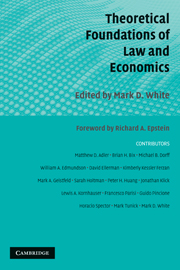Book contents
- Frontmatter
- Contents
- Foreword
- Preface
- Notes on Contributors
- PART ONE THE ROLE AND USE OF ECONOMICS IN LEGAL STUDIES
- PART TWO EFFICIENCY
- PART THREE RATIONALITY AND THE LAW
- 8 Bounded Rationality and Legal Scholarship
- 9 Emotional Reactions to Law and Economics, Market Metaphors, and Rationality Rhetoric
- 10 Pluralism, Intransitivity, Incoherence
- PART FOUR VALUES AND ETHICS IN CIVIL AND CRIMINAL LAW
- Index
- References
9 - Emotional Reactions to Law and Economics, Market Metaphors, and Rationality Rhetoric
Published online by Cambridge University Press: 06 July 2009
- Frontmatter
- Contents
- Foreword
- Preface
- Notes on Contributors
- PART ONE THE ROLE AND USE OF ECONOMICS IN LEGAL STUDIES
- PART TWO EFFICIENCY
- PART THREE RATIONALITY AND THE LAW
- 8 Bounded Rationality and Legal Scholarship
- 9 Emotional Reactions to Law and Economics, Market Metaphors, and Rationality Rhetoric
- 10 Pluralism, Intransitivity, Incoherence
- PART FOUR VALUES AND ETHICS IN CIVIL AND CRIMINAL LAW
- Index
- References
Summary
This chapter makes three fundamental points about law and economics. First, some people have strong, negative emotional reactions to utilizing microeconomics to analyze nonbusiness areas of law, whereas others have no such reactions. This chapter advances the hypothesis that people who do not view the world through an economics lens are likely to experience negative feelings toward applying microeconomics to nonbusiness law areas, whereas people who view the world through an economics lens are unlikely to do so. Second, while law and economics remains an uncontroversial subfield of applied microeconomics, it has become a dominant yet controversial field of scholarship in legal academia. This chapter proposes that differences in how most academic and professional economists perceive law and economics versus how most academic and professional lawyers perceive law and economics are due primarily to differences in how familiar they are with microeconomics presented in a mathematically rigorous fashion. Third, much research considerably and significantly qualifies many well-known and often quoted alleged benefits of competitive markets and unbounded rationality. People who comprehend this research appreciate that the extent to which markets and rationality are socially desirable is more complicated than people who do not understand this research often suggest. This research involves traditional microeconomics, behavioral economics, cognitive psychology, social psychology, and neuroeconomics.
EMOTIONAL AND UNEMOTIONAL REACTIONS TO LAW AND ECONOMICS
It is uncontroversial to apply economics to analyze business-related law fields. Most applications of economics to law utilize microeconomics, but a few applications of macroeconomics to law exist.
- Type
- Chapter
- Information
- Theoretical Foundations of Law and Economics , pp. 163 - 183Publisher: Cambridge University PressPrint publication year: 2008
References
- 3
- Cited by



